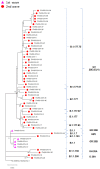Origin, Genetic Variation and Molecular Epidemiology of SARS-CoV-2 Strains Circulating in Sardinia (Italy) during the First and Second COVID-19 Epidemic Waves
- PMID: 36851491
- PMCID: PMC9961045
- DOI: 10.3390/v15020277
Origin, Genetic Variation and Molecular Epidemiology of SARS-CoV-2 Strains Circulating in Sardinia (Italy) during the First and Second COVID-19 Epidemic Waves
Abstract
Understanding how geography and human mobility shape the patterns and spread of infectious diseases such as COVID-19 is key to control future epidemics. An interesting example is provided by the second wave of the COVID-19 epidemic in Europe, which was facilitated by the intense movement of tourists around the Mediterranean coast in summer 2020. The Italian island of Sardinia is a major tourist destination and is widely believed to be the origin of the second Italian wave. In this study, we characterize the genetic variation among SARS-CoV-2 strains circulating in northern Sardinia during the first and second Italian waves using both Illumina and Oxford Nanopore Technologies Next Generation Sequencing methods. Most viruses were placed into a single clade, implying that despite substantial virus inflow, most outbreaks did not spread widely. The second epidemic wave on the island was actually driven by local transmission of a single B.1.177 subclade. Phylogeographic analyses further suggest that those viral strains circulating on the island were not a relevant source for the second epidemic wave in Italy. This result, however, does not rule out the possibility of intense mixing and transmission of the virus among tourists as a major contributor to the second Italian wave.
Keywords: SARS-CoV-2; genetic diversity; molecular epidemiology; spike (S) protein; whole genome sequencing.
Conflict of interest statement
The authors declare no conflict of interest.
Figures






Similar articles
-
On the Origin and Propagation of the COVID-19 Outbreak in the Italian Province of Trento, a Tourist Region of Northern Italy.Viruses. 2022 Mar 11;14(3):580. doi: 10.3390/v14030580. Viruses. 2022. PMID: 35336987 Free PMC article.
-
The impact of insularity on SARS-CoV-2 diffusion: Recapitulating three years of COVID-19 pandemic in the island of Sardinia.J Infect Public Health. 2024 Aug;17(8):102496. doi: 10.1016/j.jiph.2024.102496. Epub 2024 Jul 6. J Infect Public Health. 2024. PMID: 38991412
-
Phylogeography and genomic epidemiology of SARS-CoV-2 in Italy and Europe with newly characterized Italian genomes between February-June 2020.Sci Rep. 2022 Apr 6;12(1):5736. doi: 10.1038/s41598-022-09738-0. Sci Rep. 2022. PMID: 35388091 Free PMC article.
-
Phylodynamics of SARS-CoV-2 in France, Europe, and the world in 2020.Elife. 2023 Apr 26;12:e82538. doi: 10.7554/eLife.82538. Elife. 2023. PMID: 37159510 Free PMC article.
-
Epidemiology and Genetic Analysis of SARS-CoV-2 in Myanmar during the Community Outbreaks in 2020.Viruses. 2022 Jan 27;14(2):259. doi: 10.3390/v14020259. Viruses. 2022. PMID: 35215852 Free PMC article.
Cited by
-
A quantitative investigation in a territory of Italy on citizens' attitudes towards medicines through the COVID-19 pandemic: the importance of possible indirect effects caused by the pandemic.J Pharm Policy Pract. 2024 Oct 29;17(1):2418366. doi: 10.1080/20523211.2024.2418366. eCollection 2024. J Pharm Policy Pract. 2024. PMID: 39479053 Free PMC article.
References
-
- World Health Organization . Health Topics: Emerging Diseases. World Health Organization; Geneva, Switzerland: [(accessed on 20 September 2022)]. Available online: http://www.who.int/topics/emerging_diseases/en/
-
- World Health Organization Regional Office for South-East Asia, 2014. A Brief Guide to Emerging Infectious Diseases and Zoonoses. [(accessed on 20 September 2022)]. Available online: https://apps.who.int/iris/handle/10665/204722.
Publication types
MeSH terms
LinkOut - more resources
Full Text Sources
Medical
Miscellaneous

